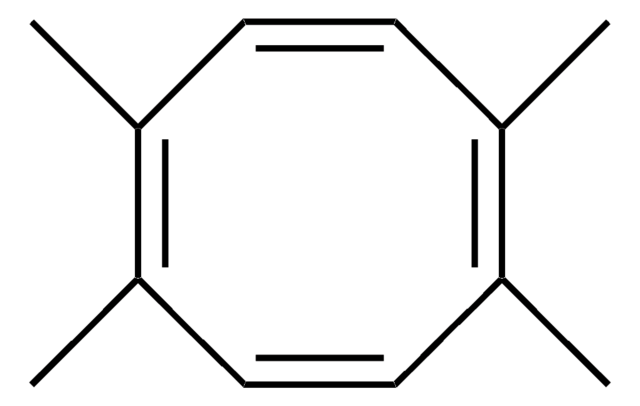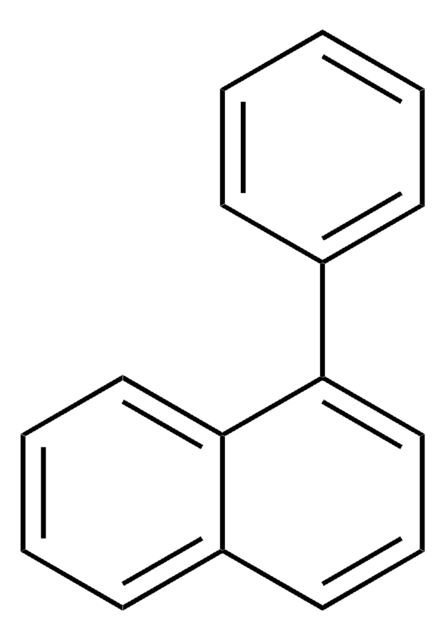P10801
Perinaphthenone
97%
Synonym(s):
1H-Benzonaphthen-1-one, 7-Perinaphthenone, Phenalenone, Phenalone
Sign Into View Organizational & Contract Pricing
All Photos(1)
About This Item
Empirical Formula (Hill Notation):
C13H8O
CAS Number:
Molecular Weight:
180.20
EC Number:
MDL number:
UNSPSC Code:
12352100
PubChem Substance ID:
NACRES:
NA.22
Recommended Products
Assay
97%
form
powder
mp
153-156 °C (lit.)
SMILES string
O=C1C=Cc2cccc3cccc1c23
InChI
1S/C13H8O/c14-12-8-7-10-4-1-3-9-5-2-6-11(12)13(9)10/h1-8H
InChI key
WWBGWPHHLRSTFI-UHFFFAOYSA-N
Storage Class Code
11 - Combustible Solids
WGK
WGK 3
Flash Point(F)
Not applicable
Flash Point(C)
Not applicable
Personal Protective Equipment
dust mask type N95 (US), Eyeshields, Gloves
Certificates of Analysis (COA)
Search for Certificates of Analysis (COA) by entering the products Lot/Batch Number. Lot and Batch Numbers can be found on a product’s label following the words ‘Lot’ or ‘Batch’.
Already Own This Product?
Find documentation for the products that you have recently purchased in the Document Library.
Customers Also Viewed
William Hidalgo et al.
Journal of agricultural and food chemistry, 57(16), 7417-7421 (2009-07-28)
The levels of native fungitoxic perinaphthenone phytoalexins in susceptible Musa varieties (banana), which are commercially grown in large plantations, are too low to provide plants with long-lasting protection against highly pathogenic fungi. Novel strategies for plant protection are necessary to
Cristina Flors et al.
Accounts of chemical research, 39(5), 293-300 (2006-05-17)
Plants defend themselves from pathogen infections or mechanical injury by a number of mechanisms, including the induced biosynthesis of antimicrobial secondary metabolites. These compounds, termed phytoalexins, represent a very economical way to counteract hazard, because the carbon and energy resources
S Opitz et al.
Planta, 216(5), 881-889 (2003-03-08)
Phenylphenalenones represent a typical group of secondary metabolites of the Haemodoraceae. Some of these phenolic compounds show organ-specific distribution within the plant. However, detailed information on cellular localisation is still lacking. To this end, confocal laser-scanning microscopy, microspectral photometry and
Mahmoud F Elsebai et al.
Natural product reports, 31(5), 628-645 (2014-04-02)
Covering up to the end of August 2013. Phenalenones are members of a unique class of natural polyketides exhibiting diverse biological potential. This is a comprehensive review of 72 phenalenones with diverse structural features originating from fungal sources. Their bioactive
Felipe Otálvaro et al.
Journal of natural products, 70(5), 887-890 (2007-04-13)
Two perinaphthenone-type compounds (1 and 2) were isolated together with four known phenylphenalenones (3-6) from the rhizomes of Musa acuminata var. "Yangambi km 5". The structures of the new phenalenones were assigned as 2-hydroxy-1H-phenalen-1-one (1) and 2-methoxy-1H-phenalen-1-one (2) on the
Our team of scientists has experience in all areas of research including Life Science, Material Science, Chemical Synthesis, Chromatography, Analytical and many others.
Contact Technical Service




![Cyclopenta[d,e,f]phenanthrene 97%](/deepweb/assets/sigmaaldrich/product/structures/107/640/eed40ce0-e715-4438-9cb3-dc3dc13dcb9b/640/eed40ce0-e715-4438-9cb3-dc3dc13dcb9b.png)



